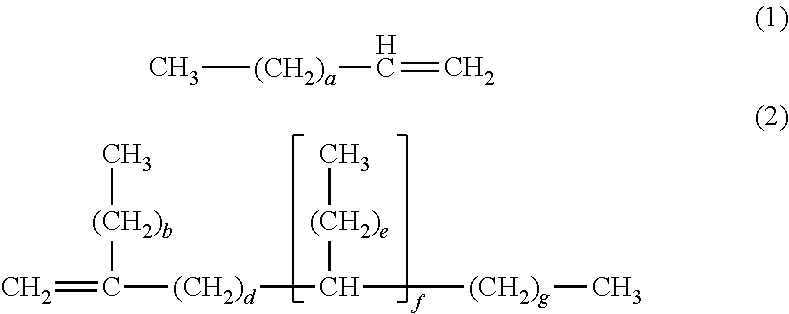Release modifier and release coating organopolysiloxane composition
a technology of organopolysiloxane and release modifier, which is applied in the direction of coating, transportation and packaging, layered products, etc., can solve the problems of unsatisfactory temporal stability of the release force, the coating yielded by the compositions cited above, and the release force lightens with the passage of time, so as to achieve excellent handling properties, excellent release properties, and low viscosity
- Summary
- Abstract
- Description
- Claims
- Application Information
AI Technical Summary
Benefits of technology
Problems solved by technology
Method used
Image
Examples
synthesis example 1
[Production of Release Modifier (1)]
[0122]The following starting materials were charged to a 2-liter separable flask equipped with a thermometer, condenser, and stirrer and were stirred for 30 minutes.[0123](a1-1) methylpolysiloxane resin:
[0124]
M0.74Q1 (OH quantity = 0.74%)300 g[0125](a2-1) straight-chain dimethylpolysiloxane chain-stopped by hydroxydimethylsiloxy at both molecular chain terminals:
[0126]
MOHD330MOH128 gxylene444 g
[0127]After these starting materials had been mixed to homogeneity, the temperature was raised to 40° C.; 5 g of 28% aqueous ammonia solution (a3) was added; and a reaction was carried out for approximately 5 hours. This was followed by the installation of a water trap; the temperature was raised to 140° C.; the water of condensation and ammonia were removed over 2 hours; and cooling to room temperature then yielded a xylene solution of a release modifier (1) comprising a methylpolysiloxane resin-dimethylpolysiloxane condensate.
[0128]The hydroxyl group (sila...
synthesis example 2
[Synthesis Example 2]
[Production of Release Modifier (2)]
[0129]The xylene solution of a release modifier (2) was obtained by proceeding in the same manner as in Release Modifier Synthesis Example 1, but in this case using 256 g for the amount of addition of component (a2-1) (=MOHD330MOH) in Synthesis Example 1. In addition, in order to adjust the viscosity, 556 g of a dimethylvinylsiloxy chain-stopped straight-chain dimethylpolysiloxane (MViD60MVi) was added to the xylene solution of the release modifier (2). After mixing to homogeneity in about 30 minutes, the xylene was removed by stripping to obtain a dimethylpolysiloxane solution of the release modifier (2) (release modifier (2) content=50 weight %).
[0130]The hydroxyl group (silanol group) content of release modifier (2) is given in Table 1. The viscosity of the dimethylpolysiloxane solution of release modifier (2) is also shown in Table 1.
synthesis example 3
[Production of Release Modifier (3)]
[0131]The xylene solution of a release modifier (3) and the dimethylpolysiloxane solution of the release modifier (3) were obtained by proceeding as in Release Modifier Synthesis Example 1, but in this case replacing component (a2-1) in Synthesis Example 1 with the following.
[0132]
(a2-2) MOHD400MOH128 g
[0133]The hydroxyl group (silanol group) content of this release modifier (3) is given in Table 1. The viscosity of the dimethylpolysiloxane solution of release modifier (3) is also shown in Table 1 (release modifier (3) content=50 weight %).
PUM
| Property | Measurement | Unit |
|---|---|---|
| molar ratio | aaaaa | aaaaa |
| molar ratio | aaaaa | aaaaa |
| viscosity | aaaaa | aaaaa |
Abstract
Description
Claims
Application Information
 Login to View More
Login to View More - R&D
- Intellectual Property
- Life Sciences
- Materials
- Tech Scout
- Unparalleled Data Quality
- Higher Quality Content
- 60% Fewer Hallucinations
Browse by: Latest US Patents, China's latest patents, Technical Efficacy Thesaurus, Application Domain, Technology Topic, Popular Technical Reports.
© 2025 PatSnap. All rights reserved.Legal|Privacy policy|Modern Slavery Act Transparency Statement|Sitemap|About US| Contact US: help@patsnap.com



